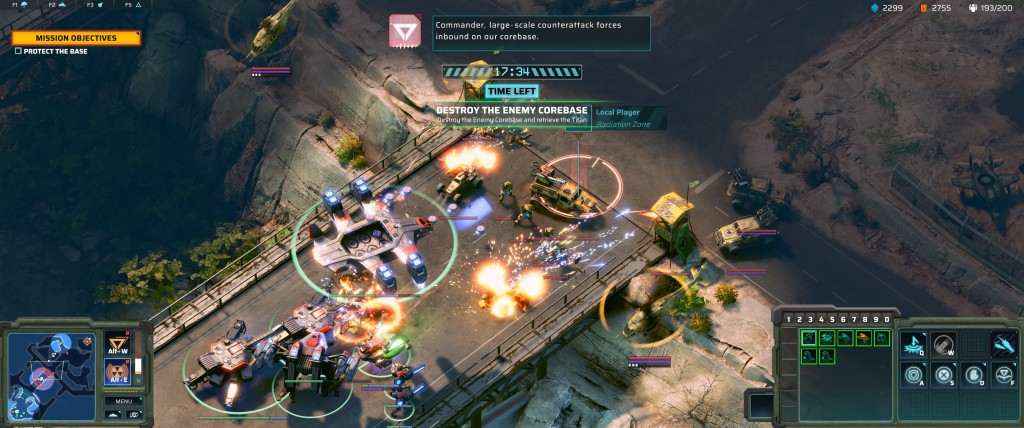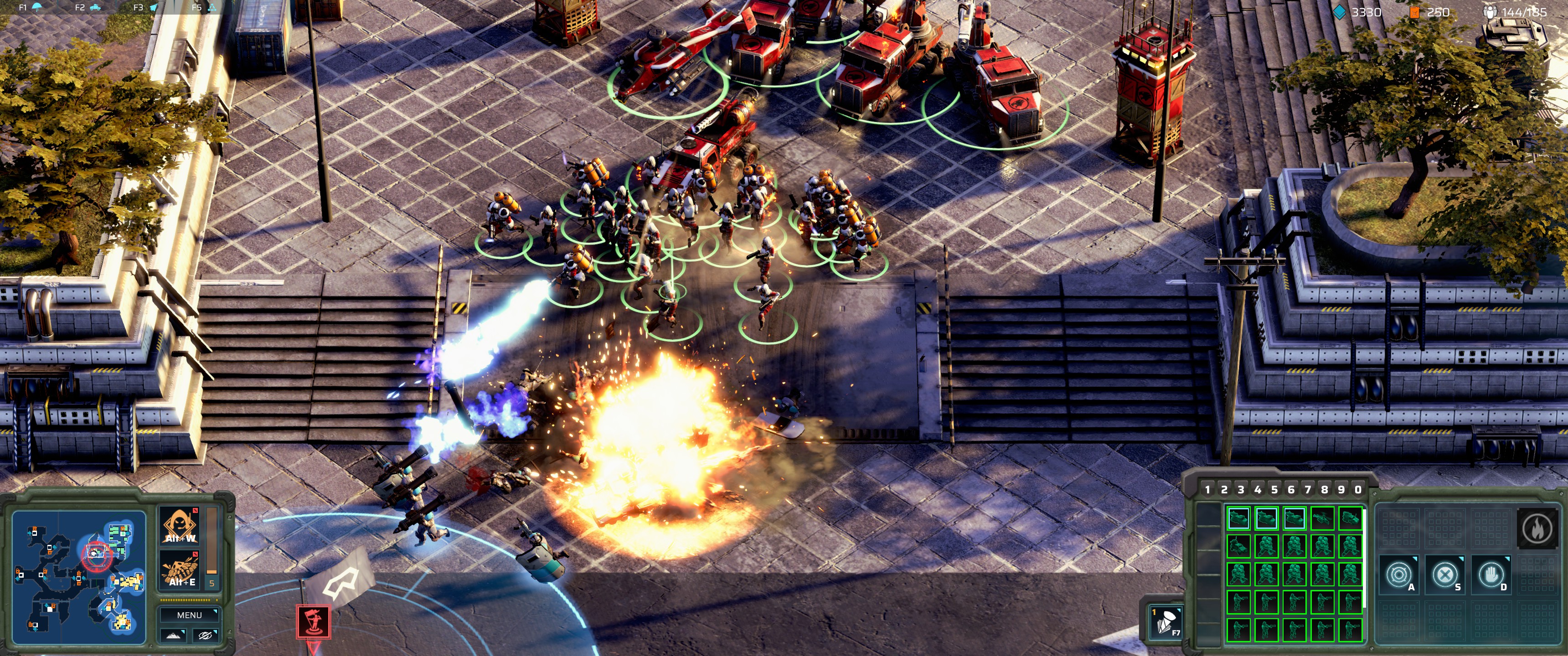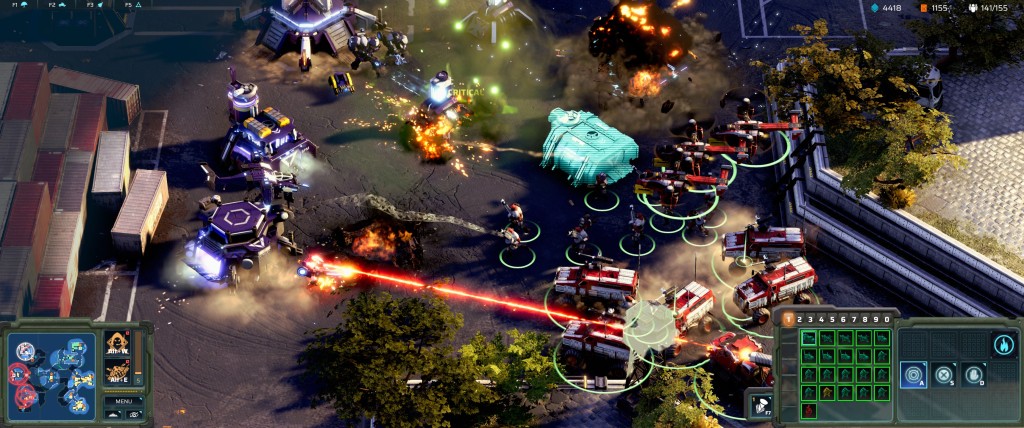
The Crossfire franchise was something of a mystery to me, a name that has been around since the early 2000’s and boasts of being the biggest FPS in the world. Yet, like me, you probably haven’t even heard of it. In 2020 the free-to-play shooter laid claim to a whopping 6 million active players, with most of those being in Asia, and has grossed over $ 10 billion. Over the past few years, there’s been an effort to push Crossfire into Western markets, as well as turn into a multi-genre franchise. So, with my limited knowledge of what Crossfire is, I decided to check out Crossfire: Legion, an RTS developed by Canadian studio Blackbird Interactive.
God knows they don’t seem interested in helping out newcomers to the Crossfire world, though. The 15-mission campaign immediately hurls you into a futuristic ongoing battle between three factions: Black List, Global Risk and New Horizon, all of whom are battling it out in a dystopian future where huge companies are the dominant forces. Global Risk is the typical corporate military boasting sleek tech in the form of fairly standard tanks and jets. Black List are the scrappy rebels who somehow have access to stealth tech. And finally, New Horizon is a futuristic bunch using fancy AI and stompy mechs.
The action kicks off with you assaulting a series of skyscrapers in a bid to capture valuable data. It’s certainly a fun premise for a mission but at no point does the game try to fill you in on what’s actually going on or why the factions are fighting or even what each faction’s modus operandi is. It really doesn’t get much better: the cutscenes are rendered in a cool visual style and the voice acting is kind of decent thanks to some big names like Ashley Burch and Elias Toufexis, but the game’s in a big rush and doesn’t have time to establish the world, conflict or characters. Who the hell is Viper? Wait, that’s his brother? Who’s that chick? I’m playing as a different faction? Okay, but how are they any different from the other two? And who the hell are these guys!? It makes the attempts at big, dramatic moments laughably bad because who cares when you can’t even remember their names.
By the time the credits came scrolling down the screen, I still didn’t really know what had happened or what brought about the war in the first place. I knew about the world, either, nor the greater context of the Crossfire universe It failed miserably at telling a coherent, enjoyable story and as a direct result made me care even less about the Crossfire franchise than when I first started playing. And then it had the audacity to set up a sequel in its closing moments. Look, can we just focus on making this game first?
- Available On: PC
- Reviewed On: PC
- Developed By: Blackbird Interactive
- Published By: Prime Matter
Review code provided by the publisher.
That’s not the only failing of the campaign, either. Let’s assume for a moment that Crossfire: Legion is actually designed for pre-existing players of the franchise. If that’s the case one could reasonably assume that they may not be well-versed in the RTS genre, a far cry from the first-person shooting of the other Crossfire titles. The campaign, then, needs to be an education in not only the basic foundational principles of movement, unit selection and base-building but also the more advanced concepts needed to jump into multiplayer like grouping, what units are good against others, hot keys and more. Crossfire: Legion does almost none of this. It provides the most basic of instruction and even fails to include a few buildings and concepts that exist in the rest of the game. Hell, you almost never get the whole gamut of stuff to play with, either – usually, you just get a couple of units and buildings to choose from.
Look, there is some good news, though – the campaign does have some fun mission designs. Like dodging enemy patrols to take out bases stealthily or ordering troops with jetpacks to jump from ship to ship, taking out defences as they go. Most of the missions are on the short side, completable in 5-15 minutes usually, but that does mean they don’t tend to overstay their welcome. Overall, then, I’d say the campaign is passable but is leagues away from offering the kind of memorable experience that the best RTS games offer, like one of my favourites which I reviewed in 2021, the venerable Warhammer 40k: Dawn of War series.
Since the campaign isn’t very interested in defining the three factions, allow me to give you a rough rundown, at least in terms of how they play. Global Risk is the all-rounder of the three and looks like your typical NATO force with some sci-fi twists. They deploy quite traditional tanks, helicopters and troopers. Black List are the scrappier rebel forces with an emphasis on hit-and-run tactics as well as some stealth capabilities. They are especially good at sneaky base ambushes, possibly the only reason to bother with the otherwise mostly useless base defences. Finally, New Horizon are the slowest of the three, their units slower to produce and move around, but more powerful, culminating in a big, stompy mech. Of the three, it’s New Horizon that feels the most different, with both Black List and Global Risk (I swear that sounds like an insurance company) playing largely the same.

The gameplay feels heavily influenced by both Command & Conquer and Starcraft. Your base is surrounded by two resource points, Materials and Fuel, and you churn out worker vehicles to shuttle those resources to and fro. Other spots on the map can have a base built on them, too, pushing you to expand your operation in order to generate resources faster than anyone else. With resources in hand, you’ll plonk down basic barracks, factories and airfields in order to create and deploy your army while researching a handful of upgrades and throwing down buildings that increase the number of units you can have. That said, the maximum army says is pretty small, especially when you deploy the bigger stuff, and the amount of buildings and units you can create is very limited, keeping the action streamlined but also very basic. In other words, if you like your RTS games big, look elsewhere.
The pace of the gameplay is definitely on the quicker side, again feeling a lot like the legendary Starcraft 2 or the classic Command & Conquer series. There are no prolonged battles or grinding out lengthy tech trees – a handful of units you can build and small maps mean it’s all about throwing out orders quickly and making sure you respond with the right tools. The biggest tactical decisions come from what to build, when to build it and how many to build of it. Those initial decisions feel like they impact the rest of the game the most, so I think competitive multiplayer will come down to figuring out optimal build orders and the number of clicks per minute a player can achieve. That’s a problem. Not for the game, just for me personally because I love to turtle up and build an absurdly huge base before constructing huge amounts of missiles or artillery.
Once the combat starts, many units have a special ability they can deploy but I found that stuff gets destroyed so quickly it can be hard to make good use of these abilities. Most battles are over in 30 seconds, maybe a minute. Again, it’s a pretty fast pace, bolstered by the standard rock-paper-scissors concept that means certain units can be decimated very quickly by their counter. You can hurl big blobs of units at problems but players who pay attention to composition will fare far better.
There are really only two areas in which Crossfire: Legion takes a chance and tries something a little different, though both concepts have appeared in other RTS titles in the past. Instead of having every unit at your disposal during a match, you choose your loadout before dropping in, picking one unit out of three or four choices per slot, of which there are five. On paper the idea seems to be pushing players to really consider their gameplay ahead of the match, discover what units fit their playstyle and make an important decision about how they intend on tackling the other players. But in reality, it’s a frustrating system that locks you into a game plan and unable to adapt on the fly. If you brought the wrong build the enemy will steamroll you, and only a colossal fuck-up on their end will give you a chance to fight back.

This whole card system was built upon the initial concept of players having to unlock new cards using in-game money. During the game’s Early Access period, the feedback was clear; people don’t like the idea, and the developers ditched it while retaining the cards.
The second concept is commanders who bring special abilities to battles. Each faction has three to choose from and offers stuff like artillery barrages, deployable mercenary bases or teleportation. The way you use these vary on the mode, with some giving you limited usage and others providing a way to recharge them. Either way, these abilities are not hugely spectacular but they can turn the tide of most fights, and in a standard skirmish match their limited use makes deciding when to deploy a nice, fraught decision.
Regular skirmish matches against the AI are the bread and butter of most RTS games, especially for anyone like myself who loves the genre but just can’t match the chops of the online crowd. Annoyingly, Crossfire: Legion hides them away in the custom games menu, and even more annoyingly the entire game requires an Internet connection to work, so you can’t even play offline against the bots. Up to six players or bots can engage in a skirmish match across a paltry selection of just five maps, and the game lacks some basic options like having factions be randomly selected or being able to set different difficulties for AI bots. It’s very bare-bones. The good news, though, is that the game comes with a map-making tool and in-built support for community-made maps. The bad news is that it’s kind of buggy and glitch at the moment.
I think it’s fair to say the AI does put up a decent fight. Even on medium, I found them to be a challenging foe. Pathfinding can be a real pain in the ass, however. Units struggling to properly navigate terrain has often proved a sore spot in the genre, and Crossfire: Legion’s AI suffers from the same ailment. That can lead to annoying moments where you have to select units amidst the chaos and try to nudge them around a corner or something to where you actually need them.
But there are a few other modes to explore, starting with Payload. This game type pits up to four players on tight maps where the goal is to escort nuclear weapons, with the first team to get three claiming the win. The key here is that there are no other resource points on the map, so everybody generates the same amount of resources at the same rate. It can lead to some really fun back-and-forth battles over the payload where devoting all your forces to the objective can leave your base vulnerable to sneaky attacks.

There’s also an interesting cooperative game mode where you team up with a few other folks to tackle a single AI that dispatches waves of units while you try to hold them off. Battlelines is a weird addition where you build units on a pad, then they get spawned onto the battlefield where they march down lanes to their doom. This one feels like a throwaway, as does Brawl where the game automatically creates and upgrades units so that all you have to focus on is commanding them.
Like all multiplayer modes, the biggest potential issue is longevity. Without a solid, engaged player base the multiplayer will die out and that already seems to be happening. At the time of writing, Steam Charts shows Crossfire: Legion had an average of just 40 players over the last 30 days. So unless you feel like you can convince a small army of people to join you, don’t buy this purely for the multiplayer.
Crossfire: Legion is best described as a purely adequate RTS, which is why I’ve struggled to review it. Games like this are the hardest to talk about because there’s nothing that is worth dissecting or getting excited about. The gameplay is fine, the campaign is passable but dull and the online is already struggling to hold a healthy player base. Even though we have been starved of RTS titles recently, the only reason to buy Crossfire: Legion is if you’ve already played everything else and you really need to scratch that real-time strategy itch.
If you are a true video game enthusiast who dreams about a career in this field, consider reviewing game design apprentice jobs, make your hobby a career




